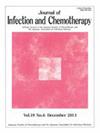Efficacy and safety of switching to long-acting cabotegravir + rilpivirine versus continuing bictegravir/emtricitabine/tenofovir alafenamide in Japanese participants: 12-month results from the phase 3b randomized SOLAR trial
IF 1.5
4区 医学
Q3 INFECTIOUS DISEASES
引用次数: 0
Abstract
In the phase 3b SOLAR study, switching to long-acting cabotegravir + rilpivirine (CAB+RPV LA) administered every 2 months (Q2M) was non-inferior to continuing daily oral bictegravir/emtricitabine/tenofovir alafenamide (BIC/FTC/TAF). We present a post hoc analysis of Japanese participants. SOLAR is a randomized (2:1), open-label, multicenter, non-inferiority study of virologically suppressed participants switching to CAB+RPV LA Q2M (with or without oral lead-in) versus continuing BIC/FTC/TAF. The primary endpoint was HIV-1 RNA ≥50 copies/mL at Month 12 (Snapshot algorithm). Of 670 participants (modified intention-to-treat–exposed population), 20 were from Japan (LA, n = 14; BIC/FTC/TAF, n = 6). At Month 12, no participants in either Japanese group had HIV-1 RNA ≥50 copies/mL; 86 % (12/14; 2 participants withdrew) versus 100 % (6/6) had HIV-1 RNA <50 copies/mL in the LA versus BIC/FTC/TAF groups; none had confirmed virologic failure. Withdrawals were due to a non–drug-related adverse event (AE; acute hepatitis B) and a physician decision. Excluding injection site reactions, drug-related AE rates were higher in the LA group (36 % vs 17 %; all grade 1 or 2). No drug-related serious AEs were reported. Injection site reactions were common (100 % [13/13] of LA participants); all were grade 1 or 2; none led to withdrawal; median duration was 4 days. Mean treatment satisfaction scores improved from baseline to Month 12 in the LA versus BIC/FTC/TAF Japanese groups (+6.25 vs + 0.33 on a 66-point scale). Though limited, these data suggest switching to CAB+RPV LA from BIC/FTC/TAF was well tolerated in Japanese participants, with comparable efficacy and improved treatment satisfaction.
ClinicalTrials.gov; NCT04542070 (https://www.clinicaltrials.gov/study/NCT04542070).
在日本参与者中,转向长效卡波特韦+利匹韦林与继续使用比替格拉韦/恩曲他滨/替诺福韦阿拉芬胺的疗效和安全性:来自3b期随机SOLAR试验的12个月结果
在3b期SOLAR研究中,每2个月(Q2M)给予长效卡替格拉韦+利匹韦林(CAB+RPV LA)的疗效不低于持续每日口服比替格拉韦/恩曲他滨/替诺福韦(BIC/FTC/TAF)。我们对日本参与者进行了事后分析。SOLAR是一项随机(2:1),开放标签,多中心,非劣效性研究,病毒学抑制的参与者切换到CAB+RPV LA Q2M(有或没有口服引入物)与继续BIC/FTC/TAF。主要终点是第12个月时HIV-1 RNA≥50拷贝/mL(快照算法)。670名参与者(修改意向治疗暴露人群)中,20名来自日本(LA, n=14;BIC / FTC / TAF, n = 6)。在第12个月,日本两组的参与者都没有HIV-1 RNA≥50拷贝/mL;86% (12/14;2名参与者退出)vs 100%(6/6)有HIV-1 RNA
本文章由计算机程序翻译,如有差异,请以英文原文为准。
求助全文
约1分钟内获得全文
求助全文
来源期刊

Journal of Infection and Chemotherapy
INFECTIOUS DISEASES-PHARMACOLOGY & PHARMACY
CiteScore
4.10
自引率
4.50%
发文量
303
审稿时长
47 days
期刊介绍:
The Journal of Infection and Chemotherapy (JIC) — official journal of the Japanese Society of Chemotherapy and The Japanese Association for Infectious Diseases — welcomes original papers, laboratory or clinical, as well as case reports, notes, committee reports, surveillance and guidelines from all parts of the world on all aspects of chemotherapy, covering the pathogenesis, diagnosis, treatment, and control of infection, including treatment with anticancer drugs. Experimental studies on animal models and pharmacokinetics, and reports on epidemiology and clinical trials are particularly welcome.
 求助内容:
求助内容: 应助结果提醒方式:
应助结果提醒方式:


